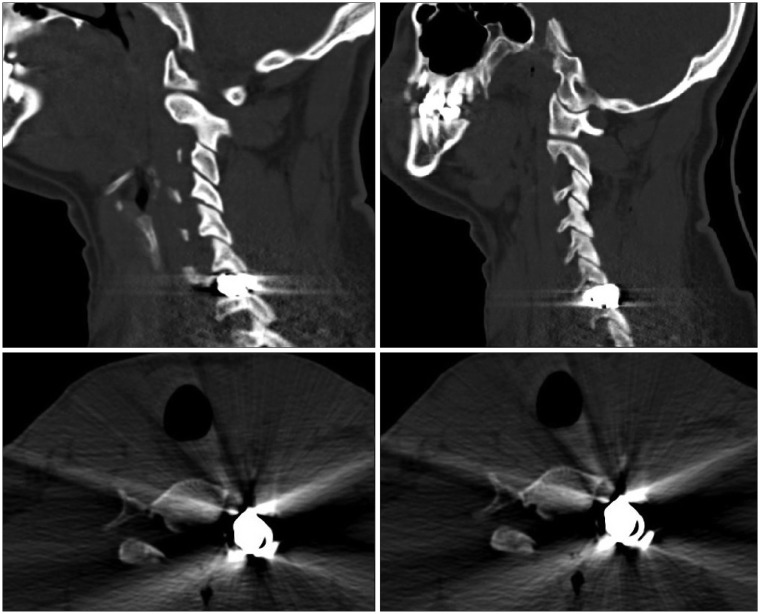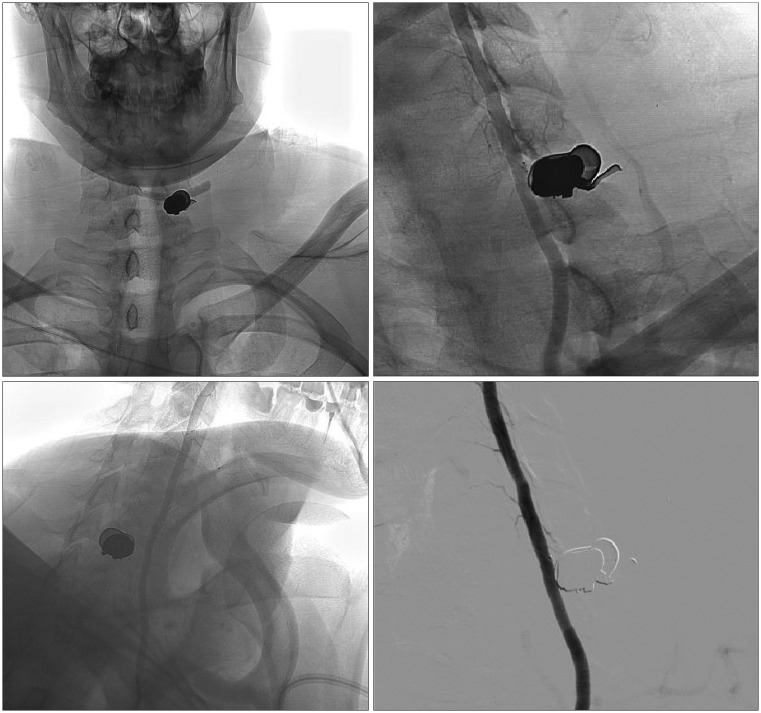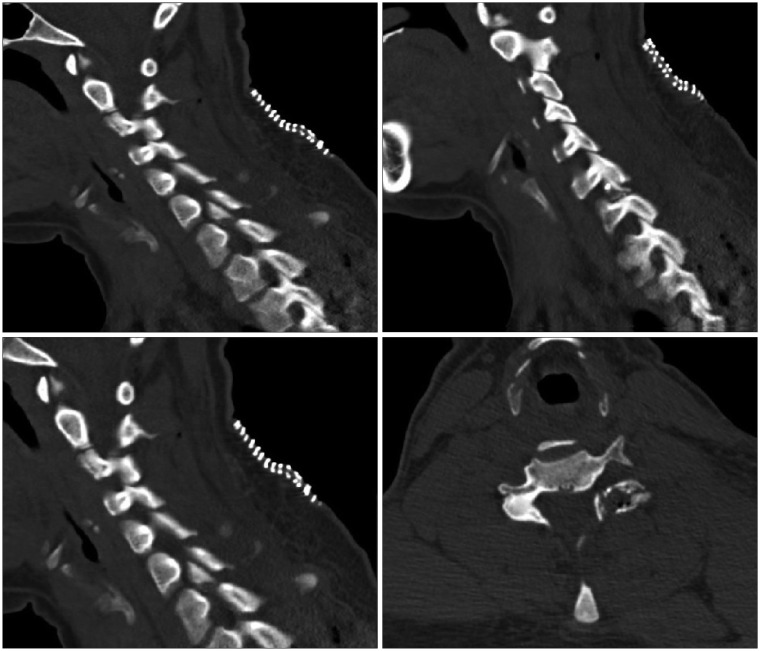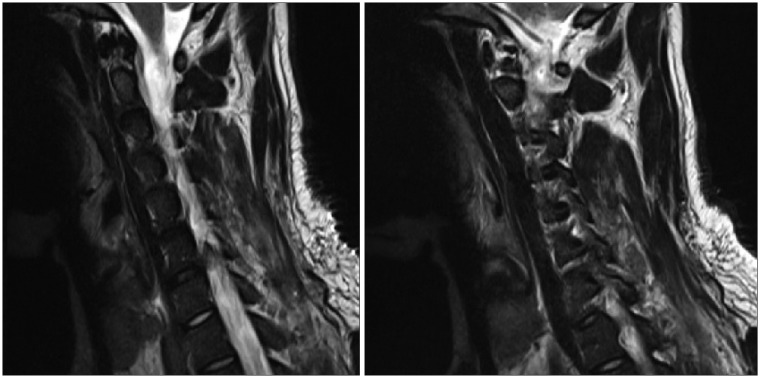Korean J Neurotrauma.
2017 Apr;13(1):45-49. 10.13004/kjnt.2017.13.1.45.
Incomplete Isolated C7 Root Injury Caused by Gunshot Wound: A Case Report
- Affiliations
-
- 1Department of Neurosurgery, Bakırköy Sadi Konuk Training and Research Hospital, Istanbul, Turkey.
- 2Department of Neurosurgery, Tokat State Hospital, Tokat, Turkey. ahmettolgayakinci@gmail.com
- 3Department of Neurosurgery, Edirne State Hospital, Edirne, Turkey.
- KMID: 2378250
- DOI: http://doi.org/10.13004/kjnt.2017.13.1.45
Abstract
- Gunshot wounds to the spine cause severe neurological and/or internal organs damages. Although most of publications in the literature are realized on military injuries, increased civilian arming which raises civilian gunshot injuries is a new social danger causing serious health problems. In gunshot injuries to the spine; vertebral column, spinal cord and nerve roots are damaged with direct, indirect and transient cavitation related mechanisms. In this case report, we present 24 years old male patient who had severe pain and monoparesis in left upper extremity followed by gunshot injury to the spine with clinical, radiological and postoperative follow-up findings.
MeSH Terms
Figure
Reference
-
1. Aarabi B, Alibaii E, Taghipur M, Kamgarpur A. Comparative study of functional recovery for surgically explored and conservatively managed spinal cord missile injuries. Neurosurgery. 1996; 39:1133–1140. PMID: 8938767.
Article2. Aryan HE, Amar AP, Ozgur BM, Levy ML. Gunshot wounds to the spine in adolescents. Neurosurgery. 2005; 57:748–752. discussion 748-752. PMID: 16239887.
Article3. Bono CM, Heary RF. Gunshot wounds to the spine. Spine J. 2004; 4:230–240. PMID: 15016402.
Article4. Dalgic A, Okay O, Nacar O, Daglioglu E, Pasaoglu L, Belen D. Vertebral artery insult at the transverse foramina by gun shot wounds: report of two cases. Turk Neurosurg. 2009; 19:413–416. PMID: 19847764.5. Farmer JC, Vaccaro AR, Balderston RA, Albert TJ, Cotler J. The changing nature of admissions to a spinal cord injury center: violence on the rise. J Spinal Disord. 1998; 11:400–403. PMID: 9811100.6. Golueke P, Sclafani S, Phillips T, Goldstein A, Scalea T, Duncan A. Vertebral artery injury--diagnosis and management. J Trauma. 1987; 27:856–865. PMID: 3612862.
Article7. Heary RF, Vaccaro AR, Mesa JJ, Balderston RA. Thoracolumbar infections in penetrating injuries to the spine. Orthop Clin North Am. 1996; 27:69–81. PMID: 8539054.
Article8. Hecimovic I, Vrankovic D, Rubin O, Maksimovic Z, Rukovanjski M. Transoral missile removal from the anterior C1 region following transpharyngeal missile wound. Arch Orthop Trauma Surg. 1999; 119:340–343. PMID: 10447636.9. Hossin J, Joorabian M, Pipelzadah M. A firearm bullet lodged into the thoracic spinal canal without vertebral bone destruction: a case report. J Med Case Rep. 2011; 5:289. PMID: 21733154.
Article10. Kahraman S, Gonul E, Kayali H, Sirin S, Duz B, Beduk A, et al. Retrospective analysis of spinal missile injuries. Neurosurg Rev. 2004; 27:42–45. PMID: 12884053.
Article11. Klein Y, Cohn SM, Soffer D, Lynn M, Shaw CM, Hasharoni A. Spine injuries are common among asymptomatic patients after gunshot wounds. J Trauma. 2005; 58:833–836. PMID: 15824664.
Article12. Mangiardi JR, Alleva M, Dynia R, Zubowski R. Transoral removal of missile fragments from the C1-C2 area: report of four cases. Neurosurgery. 1988; 23:254–257. PMID: 3185888.
Article13. Müller CA, Peters I, Podlogar M, Kovacs A, Urbach H, Schaller K, et al. Vertebral artery injuries following cervical spine trauma: a prospective observational study. Eur Spine J. 2011; 20:2202–2209. PMID: 21717238.
Article14. Parent AD, Harkey HL, Touchstone DA, Smith EE, Smith RR. Lateral cervical spine dislocation and vertebral artery injury. Neurosurgery. 1992; 31:501–509. PMID: 1407430.
Article15. Peacock WJ, Shrosbree RD, Key AG. A review of 450 stabwounds of the spinal cord. S Afr Med J. 1977; 51:961–964. PMID: 888030.16. Reid JD, Weigelt JA. Forty-three cases of vertebral artery trauma. J Trauma. 1988; 28:1007–1012. PMID: 3398081.
Article17. Robertson DP, Simpson RK. Penetrating injuries restricted to the cauda equina: a retrospective review. Neurosurgery. 1992; 31:265–269. discussion 269-270. PMID: 1513432.18. Seçer M, Ulutaş M, Alagöz F, Uçkun ÖM, Çınar K, Yel C, et al. Relationship of biological factors to survival in spinal gunshot injuries. Ulus Travma Acil Cerrahi Derg. 2016; 22:253–258. PMID: 27598589.19. Waters RL, Adkins RH. The effects of removal of bullet fragments retained in the spinal canal. A collaborative study by the National Spinal Cord Injury Model Systems. Spine (Phila Pa 1976). 1991; 16:934–939. PMID: 1948380.
- Full Text Links
- Actions
-
Cited
- CITED
-
- Close
- Share
- Similar articles
-
- A Case Report of Ureteral Injury by Gunshot Wound
- A Case Report of Spinal Cord Injury Patient From a High Velocity Gunshot Wound to the Lumbar Spine
- Fracture of the Humeral Shaft Secondary to High-Velocity Gunshot (Machine Gun) Injury: A Case Report
- Management of a Gunshot Wound at the Temporal Region: Case Report
- A Case of Renocolic Fistula and Intrarenal Aneurysm by Gunshot Wound





